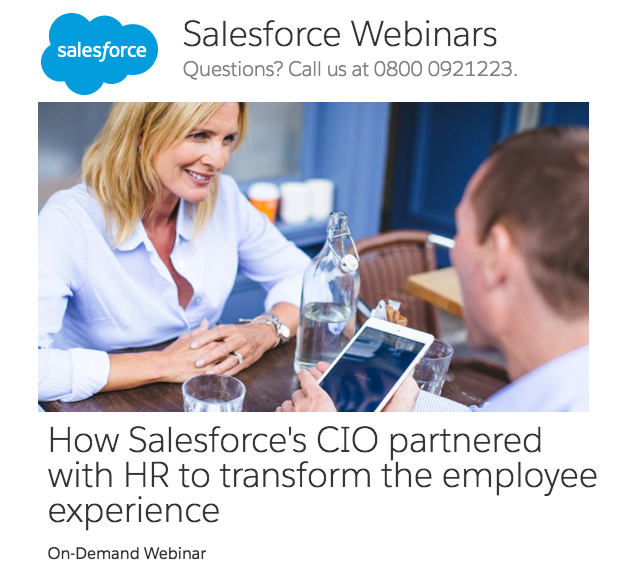There are as many formulas for success as there are successful companies, but there is one consistent variable that every organisation needs to succeed — engaged employees.
Employee engagement is a rare win-win: Take care of your employees, and they will take care of your company. It’s the right thing to do, but if you need a more compelling reason, the most recent research from Aon Hewitt showed that a 5-point increase in employee engagement is linked to a 3-point increase in revenue growth in the subsequent year.
When your people are engaged, they passionately drive your company forward, creating more innovative products and better customer experiences. They also act as brand ambassadors, attracting new customers and talent.
But, as Gallup’s research shows, this employee engagement stuff is tough. We don’t have it all figured out, but we are working on a formula that’s helped Salesforce become the fastest-growing top five enterprise software company in the world and one of the Fortune “100 Best Companies to Work For” nine years running.
And that formula is: culture + technology + data = employee engagement.
So how exactly does it work? See how Salesforce's CIO partnered with HR to transform the employee experience.
Culture: #SalesforceOhana is what differentiates us
Culture is what differentiates your company in the minds of employees. The day-to-day tasks of any job, whether it’s an account executive or a software engineer, are similar no matter where you work. What’s different is the people you do it with and the environment you do it in, and that comes down to culture. This differentiator is your greatest competitive advantage when it comes to attracting, engaging, and retaining talent.
Salesforce’s culture is centred around the concept of Ohana, which means “family” in Hawaiian. For us, Ohana doesn’t stop at our employees — it extends to our customers, partners, and communities. Our Ohana culture is at the heart our promise to employees: that they will be empowered to perform meaningful work with good people in a great environment, and will be fairly rewarded for it. When our employees feel we are delivering on our promise to them, they respond by delivering their best to our whole ecosystem.
For these reasons, we devote a significant amount of time and resources to defining our culture, hiring people who align with it, immersing new employees in it, and living and breathing it — inside and outside Salesforce. We’ll share tips on how you can define and amplify your company’s culture in the second blog in this series.
Technology: The app-tastic universe creates connections
A great culture is not enough to keep your employees engaged in our social, mobile, smart world. Today’s consumers demand a connected and engaging experience. Companies have been racing to meet their expectations, building beautiful interfaces in useful apps that provide smart insights. But in the race to provide for customers, employees are often left behind. Don’t forget that employees are consumers, too. They have great experiences with the brands they love, and they have the same expectations of an engaging experience with the most important brand in their life – the company where they work.
That’s why we, and many of our customers, are using our customer-facing Salesforce technologies to build better tools for employees. The employee apps we’ve built on the Salesforce Platform help our people:
Get instant answers and help on the go
Manage their performance goals, and request and give feedback
Find the teammates, conversation groups, and files they need to get their work done
And take care of themselves, their families, and their communities
Remember, your employees are on the front line of every customer experience, so it makes sense to pursue a digital transformation for both customers and employees at the same time. See “How Lightning Accelerates Your Entire Business.”
Data: What we learn helps us evolve.
At Salesforce, we not only work to provide the right employee tools, we also analyse the data these technologies allow us to gather. We use the dashboards available in our products to understand how our employees could use these tools to drive their performance and deepen our relationships with customers. We also look at things like employee help-ticket data to see what slows our people down and impacts productivity. Finally, we look at their goal setting, feedback, and learning data to understand their skills and strengths. And we make smart recommendations for mentoring, learning, and career growth opportunities.
It’s insight drawn from analysing this data and taking action that has allowed us to evolve from a traditional model of human resources to a more innovative and effective employee-centred experience.
You can do this, too.
Using our “culture + technology + data = engagement” formula at every stage of the employee journey — from attraction and onboarding to ongoing engagement and advocacy — is having a positive impact across every facet of our business.
Throughout this series we’ll dive deeper into our engagement strategy and the technologies we use to accelerate it. We hope you’ll follow along to give your employees a better chance at fulfillment, while also delivering greater success for your company, your customers, and your communities.
This is the first in a series of five blog posts - see the second article Turn Your Culture into a Competitive Advantage - that look at how Salesforce engages employees and how you can, too. We hope you’ll join us as we share useful insights and actionable ideas on how we have been able to grow the company rapidly while remaining one of Fortune’s “100 Best Companies to Work For” nine years running.
In the meantime, please check out the on-demand webinar to see how Salesforce's CIO partnered with HR to transform the employee experience.








